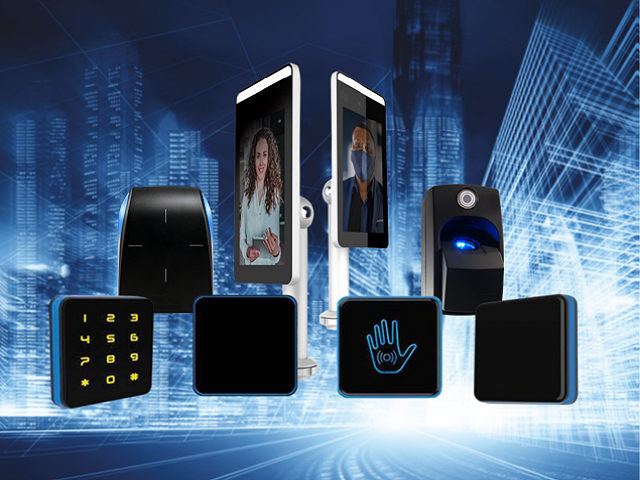Which Access Control Reader Should You Choose?
14 February 2022

Access control systems protect buildings and areas within them from unauthorised access. Not ever door will be under access control. A building will normally have a layered approach to its security, starting from the main entrance and doorways into key areas to the exit(s).
Areas under access control are dependent upon the building type and what it is used for. A manufacturing site will secure different areas for example, to a corporate office, as will a retail outlet, hospital or university. Each site will have common and specific access control requirements.
Access Controlled Doors
The first step in designing an access control system is to define the number of doorways to be monitored and controlled. This figure, coupled with the number of users, will define the size of the overall access control system and the other system components required.
Each controlled doorway will have some form of access control reader installed, either on both sides or one side with a Request to Exit (RTE) push or contactless button on the other.
Access Control Readers
There are several types of access control reader but they all provide similar functionality. That is to read the credential presented to them and to communicate this securely over an IP network to the access control system management software. The software compares permissions attached to the credential and either instructs the door controller to ‘unlock’ the doorway or not. ‘Go/No Go’ permissions can be linked to access dates and times, and this provides a further layer of security.
The most traditional credential carrier is an access control card. When the card (typically a MIFARE-type) is presented to a card reader, such as the EntroPad, the card is energised by the reader, and the stored data upon it can be read. Card readers like EntroPad are secure and can offer both card reader and pin entry to provide multi-factor authentication. EntroPad also has antimicrobial protection built-in to help prevent the spread of bacteria and viruses and can be used as a completely contactless door entry or exit (RTE) device.
Other types of reader include biometric and Bluetooth both of which use the same principle as a card reader to unlock a door.
Biometric Fingerprint Readers
The EntroWatch access control system can be used with the IEVO Ultimate fingerprint reader. The reader users a high-performance multispectral imaging (MSI) sensor to simultaneously read data from both the surface and subsurface levels of a fingerprint, even when features are hard to distinguish; due to factors such as dirt, moisture and damage.
With advanced encryption for data transmission, the fingerprint reader provides a highly accurate and quality image to reliably allow the IEVO control board to perform 1:N matching of up to 50,000 (10,000 as standard) fingerprint templates. The reader unit itself does not store any user data for an additional level of protection.
Biometric Facial Recognition Readers
The Remsdaq Face Recognition & Temperature Monitoring Camera is a facial recognition and temperature detection solution that uses artificial intelligence to provide biometric access control.
The camera terminal can accurately screen for body temperatures to within +/- 0.3°C. If the measured temperature is higher than a pre-set value, the device issues a local audible alarm and can report the event to a mobile phone and/or its computer-based monitoring software.
The camera terminal can monitor forehead temperatures within a 36-42°C range within 0.5 to 1.3m with an optimal measurement distance of 0.75m. When used for facial recognition and contactless door entry, the credential check time of the camera face to the stored database is within 1.5 to 2 seconds. The terminals can also be set to test for mask wearing.
The camera terminals provide contactless door unlocking when used with an access control system using a Wiegand Interface, including the Entro access control series.
Bluetooth Readers
The Remsdaq Bluetooth Reader is an access control reader that can be used to read smart card credentials on an Android or IOS smartphone. The reader can be configured to work in one of the following modes:
- Card: place a mobile phone in front of the Bluetooth reader
- Handsfree: simply walk past the Bluetooth reader to gain access or exit from a controlled door
- Remote: with the App open on your smartphone use the built-in remote-control feature to gain access through controlled doors and gates
- Slide: place your hand in front of the Bluetooth reader to signal your presence with your smartphone in your pocket
- Tap-Tap: open an access-controlled door by tapping your smartphone twice
The Bluetooth reader provide contactless door unlocking when used with an Entro access control system, providing a scalable system from 2 to 800 doors. The smart card mobile phone app is free (download from an App Store).
External Readers
Outside a building, types of readers can include long-range readers, that can pick-up a Bluetooth credential or vehicle automatic number plate recognition (ANPR) readers.
Summary
Card, biometric and Bluetooth readers are one of the most visible components within an access control system. They must function instantaneously to the user and present secure information to the access control system in order for the system to operate securely and provide the user with a seamless user-experience. Card readers remain the reader of choice for many sites due to both their lower cost and reliability. Biometric readers tend to be more expensive and there is still reluctance from some users to have their biometric information stored in a third-party system. Biometric readers, provide a more modern approach in that they can be used with mobile phones and smart watches, but they rely on users giving access to their devices if the company or organisation does not provide them as part of their employment.
